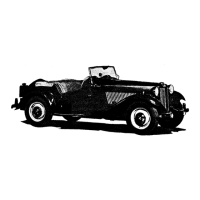---------------TIIE
FUEL SYSTEM B
between
the
armature
and
the
end
plate of
the
coil
to
return
the
armature
and diaphragm.
The
magnet consists of a cast-Iron
pot
having an Iron
core
(17). on which Is
wound
a coil of
copper
wire
which energises
the
magnet. Between
the
magnet
housing and
the
armature
are
fitted eleven spherical-
edged
brass
rollers
(10).
These
locate
the
armature
centrally within
the
magnet
at all times. and allow
absolute
freedom
of
movement
in a longitudinal direc-
tion.
The
contact
breaker
consists of a small bakelite
moulding carrying
two
rockers,
(25) and (26). which
are
both
hinged
to
the
moulding at
one
end
and
are
connected
together
at
the
top
end
by
two
small springs,
arranged
to
give
a"
throw
over"
action. A
trunnion
is fitted
Into
the
centre
of
the
inner
rocker.
and
the
bronze
push-rod (16)
connected
to
the
armature
is
screwed
Into this.
The
outer
rocker
(26) Is fitted
with
a
tungsten
point, which makes
contact
with a
further
tungsten
point
on a
spring
blade (14). This
spring
blade is
connected
to
one
end
of
the
call. and
the
other
end
of
the
call is
connected
to
the
terminal
(20). which also serves
to
hold
the
bakelite moulding
on
the
magnet
houstng,
A
short
length of flexible
wire
is
connected
to
the
outer
rocker
and to
the
other
terminal
(23)
to
provide
the
earth
return
when
the
contacts
are
dosed.
The
rocker
mechanism Is Insulated by fibre bushes.
Two
fibre bushes
are
fitted
to
one
of
the
spindles of
the"
throw
over"
mechanism In
order
to
silence
the
operation
of
the
contact
breaker.
A
good
earth
Is essential. and
this
Is
provided
on
early models by
one
of
the
body
attachment
screws
which is
extended
to
form
a
terminal
post. Later
models have a
separate
earthing
screw
in a boss cast
on
the
magnet
houslng.
Seetion
8.3
ACTION
OF THE FUEL PUMP
The
action
of
the
pump
Is as follows
:-
When
the
pump Is
at
rest.
the
outer
rocker
lies In
the
outer
position and
the
tungsten
points
are
in
contact.
The
current
passes from
the
terminal
through
the
coil back
to
the
blade,
through
the
points
and
to
the
earth
return.
thus
energising
the
magnet
and
attracting
the
armature.
This
comes
forward.
brlnglng
the
diaph ragm
with
it and suckl ng fuel
th
rough
the
suction valve
into
the
pumping
chamber.
When
the
armature
has advanced nearly
to
the
end
of
Its
stroke
the
"throw
over"
mechanism
operates.
and
the
outer
rocker
flies back, separating
the
points
and
breaking
the
circuit.
The
spring (28)
then
pushes
the
armature
and diaphragm back. forclng
petrol
through
the
delivery valve at a
rate
determined
M.G. Mldlet (Serle$
"TD
").
Issue
2 (E) 79].45-1/53
by
the
requirements
of
the
engine. As soon as
the
armature
gets
near
the
end
of
this
stroke
the
••
throw
over"
mechanism again
operates,
the
points again
make
contact,
and
the
cycle
of
operations
Is
repeated.
Section
0.4
TO DISMANTLE
AND
REASSEMBLE
THE FUEL
PUMP
When
a
pump
comes
in for
reconditioning
the
first thIng
to
do Is
to
determine
whether
It has been
in
contact
with
gum
formation
In
the
fuel, resulting
In
the
parts In
contact
with
the
fuel becoming
coated
with
a
substance
similar
to
varnish. These deposits
also cause
the
eventual
destruction
of
the
neoprene
diaphragm.
The
easiest way
to
Identify
this
deposit
Is by
the
sense
of
smell. Place
the
outlet
union
of
the
pump
dose
to
one nostril,
put
a finger
over
the
other
nostril and
breathe.
If an unpleasant, stale smell Is
noticed It will Indicate
that
there
Is
some
gum
present
in
the
pump.
The
ordinary
sharp
acrid smell of
petrol
denotes
that
no gum Is
present.
Assuming
that
trouble
with
gum
formation
Is
Indicated,
the
whole
of
the
parts
coming
into
contact
with
petrol
will have
to
be dismantled. boiled in
20
per
cent.
caustic
soda
solution, given a
dip
In
strong
nitric
acid and
then
washed In boiling
water,
with
the
exception
of
aluminium body castings,
of
course.
which should be cleaned In methylated
spirits
only.
To
dismantle the pump
First
undo
the
filter
plug.
remove
the
filter
plug
washer
and
the
filter.
The
latter
may be found
to
be
clogged completely
with
gum.
Next
the
Inlet union
and Its
washer
should be
removed,
followed by
the
outlet
union,
outlet
union washer. valve cage, valve
cage
washer
and suction valve.
The
valve cage should
then
be dismantled by removing
the
clrcllp
retaining
the
delivery valve In place, and
the
valve itself can
then
be
withdrawn.
Next
undo
the
six
screws
holding
the
tWO
main
components
of
the
pump
together.
All
the
com-
ponents
of
the
pump
bodY-With
the
exception
of
the
washer,
but
Including
the
pump
body
Itself-should
now
be given
the
caustic
soda
and nitric acid
treat-
ment,
with
the
exception
of
aluminium bodies.
New
fibre washers should be used on
replacement.
If
there
Is no evidence
of
gum
formatIon,
proceed
as
follows
:-First
undo
the
six screws holding
the
two
parts of
the
pump
together.
The
action of
the
valves
can
then
be checked by blowing and sucking in
the
inlet
union, which
will
cfieck
the
suction
valve;
carry-
ing
out
the
same
procedure
with
the
outlet
union
will check
the
delivery valve., In
the
case of
the
former
8.3
Wishvilles Classic
Automobile Library

